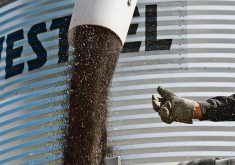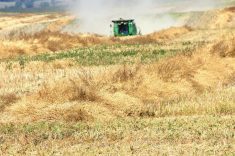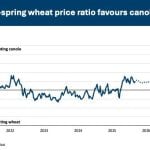Manitoba farmer Barry Reimer spent a sleepless night in late May worrying about how he was going to seed his soaked fields.
Inspiration arrived somewhere between the tossing and the turning, and five days later he was seeding and fertilizing canola in one pass, all from a tractor seat.
“A broadcast spray boom is what I would call it, and I didn’t know it would work so well,” said Reimer, who farms 3,900 acres near Killarney.
“I will do this 400 acre field in about 10 hours. It’s twice as fast as a regular seeder. We are just pulling our (seed) tank through the water, and broadcasting. I have come up with a number of farming inventions over the years, but this is my best one.”
Read Also

Farm Credit Canada partners with major Toronto innovation hub
A FCC parntership with MaRS Discovery District aims to solve technology problems in food supply chains.
Time was running out for Reimer May 30 as flooding kept him off his fields.
“Before I went to bed, I was trying to figure out how I would seed. It was just too wet. By 5 a.m. I had it figured out,” he said.
“My 19-year-old son, Eric, and an employee, Jared Kroeker, helped me make it in the farm shop. We built it over four days, and today we tried it out. It cost me about $1,000 for parts.”
He used the manifold off his new drill as well as plastic hoses, one-inch square tubing, two-by-two inch square tubing and 1.5 inch muffler pipes to build a 60-foot boom that would broadcast seed onto wet and dry ground.
It can also deliver a blend of 17 pounds granulated sulphur, 27 lb. of phosphate and 100 lb. of nitrogen per acre with the seed.
“It’s saving me application costs, of hiring someone with a floater or an airplane,” Reimer said as he drove through mud and water before temporarily shutting off the feed.
“And it’s not just that. None of those guys can do three products at once. I won’t drive through the cattails, that’s the one place I would avoid. Everywhere else is OK. It makes a clean and even application. Look at it coming out.”
A few hundred metres away, Kroeker pulled heavy harrows to a depth of three-quarters of an inch to settle in the seed and fertilizer. They planned to make two harrow passes and then pray for a little rain.
Reimer was planting into canola stubble because the rain had ended his plan to seed red spring wheat.
“We ran out of time for the wheat,” he said. “June 15 is the last date for canola, if you want crop insurance. I have another 2,100 acres left to do of canola, and with this, I will get it all done.”
Reimer said seeding with his new broadcast spray boom will cost $1,000, compared to $4,500 without it.
“The weather made me do it,” he said. “Under adverse conditions, you have to change. I want to share the idea with other farmers who maybe want to do the same thing.”














